Self-Sensing Nonlinear Ultrasonic Fatigue Crack Detection under Temperature Variation †
Abstract
1. Introduction
2. Theoretical Development
“If the test β data (βtest) exceed the baseline nonlinear parameter (βbase), a fatigue crack is detected. Otherwise, no crack alarm is triggered.”
3. Finite Element Analysis
3.1. Description of Finite Element Models
3.2. Finite Element Analysis Results
4. Experimental Validation
4.1. Description of Experimental Setup
4.2. Experimental Results
4.2.1. Frequency Domain Results
4.2.2. Estimation of Linear and Nonlinear Parameters
4.2.3. Decision-Making
5. Discussion
6. Conclusions
Author Contributions
Funding
Conflicts of Interest
References
- Hao, S. I-35W Bridge Collapse. J. Bridge Eng. 2010, 15, 608–614. [Google Scholar] [CrossRef]
- Landucci, G.; Tugnoli, A.; Busini, V.; Derudi, M.; Rota, R.; Cozzani, V. The Viareggio LPG accident: Lessons learnt. J. Loss Prev. Process Ind. 2011, 24, 466–476. [Google Scholar] [CrossRef]
- Birks, A.S.; Green, R.E. Ultrasonic Testing: 7 (Nondestructive Testing Handbook), MacIntire, P., Ed.; Subsequent Edition; The American Society For Nondestructive Testing: Columbus, OH, USA, 1991; ISBN 978-1-57117-105-4. [Google Scholar]
- Kim, J.-Y.; Jacobs, L.J.; Qu, J.; Littles, J.W. Experimental characterization of fatigue damage in a nickel-base superalloy using nonlinear ultrasonic waves. J. Acoust. Soc. Am. 2006, 120, 1266–1273. [Google Scholar] [CrossRef]
- Rao, V.V.S.J.; Kannan, E.; Prakash, R.V.; Balasubramaniam, K. Observation of two stage dislocation dynamics from nonlinear ultrasonic response during the plastic deformation of AA7175-T7351 aluminum alloy. Mater. Sci. Eng. A 2009, 512, 92–99. [Google Scholar] [CrossRef]
- Dutta, D.; Sohn, H.; Harries, K.A.; Rizzo, P. A Nonlinear Acoustic Technique for Crack Detection in Metallic Structures. Struct. Heal. Monit. 2011, 8, 251–262. [Google Scholar] [CrossRef]
- Lee, T.H.; Jhang, K.Y. Experimental investigation of nonlinear acoustic effect at crack. NDT E Int. 2009, 42, 757–764. [Google Scholar] [CrossRef]
- Semperlotti, F.; Wang, K.W.; Smith, E.C. Localization of a Breathing Crack Using Super-Harmonic Signals due to System Nonlinearity. AIAA J. 2009, 47, 2076–2086. [Google Scholar] [CrossRef]
- Solodov, I.; Wackerl, J.; Pfleiderer, K.; Busse, G. Nonlinear self-modulation and subharmonic acoustic spectroscopy for damage detection and location. Appl. Phys. Lett. 2004, 84, 5386–5388. [Google Scholar] [CrossRef]
- Ohara, Y.; Mihara, T.; Yamanaka, K. Effect of adhesion force between crack planes on subharmonic and DC responses in nonlinear ultrasound. Ultrasonics 2006, 44, 194–199. [Google Scholar] [CrossRef] [PubMed]
- Semperlotti, F.; Wang, K.W.; Smith, E.C. Localization of a breathing crack using nonlinear subharmonic response signals. Appl. Phys. Lett. 2009, 95. [Google Scholar] [CrossRef]
- Kim, G.W.; Johnson, D.R.; Semperlotti, F.; Wang, K.W. Localization of breathing cracks using combination tone nonlinear response. Smart Mater. Struct. 2011, 20. [Google Scholar] [CrossRef]
- Jiao, J.; Sun, J.; Li, N.; Song, G.; Wu, B.; He, C. Micro-crack detection using a collinear wave mixing technique. NDT E Int. 2014, 62, 122–129. [Google Scholar] [CrossRef]
- Courtney, C.R.P.; Drinkwater, B.W.; Neild, S.A.; Wilcox, P.D. Factors affecting the ultrasonic intermodulation crack detection technique using bispectral analysis. NDT E Int. 2008, 41, 223–234. [Google Scholar] [CrossRef]
- Sohn, H.; Lim, H.J.; Desimio, M.P.; Brown, K.; Derriso, M. Nonlinear ultrasonic wave modulation for online fatigue crack detection. J. Sound Vib. 2014, 333, 1473–1484. [Google Scholar] [CrossRef]
- An, Y.-K.; Shen, Z.; Wu, Z. Stripe-PZT sensor-based baseline-free crack diagnosis in a structure with a welded stiffener. Sensors (Switz.) 2016, 16, 1511. [Google Scholar] [CrossRef] [PubMed]
- Liu, S.; Croxford, A.J.; Neild, S.A.; Zhou, Z. Effects of Experimental Variables on the Nonlinear Harmonic Generation Technique. IEEE Trans. Ultrason. Ferroelectr. Freq. Control 2011, 58, 1442–1451. [Google Scholar] [CrossRef] [PubMed]
- An, Y.-K.; Lee, D.J. Nonlinear Ultrasonic Fatigue Crack Detection Using a Single Piezoelectric Transducer. Proc. SPIE 2016. [Google Scholar] [CrossRef]
- Jhang, K. Nonlinear Ultrasonic Techniques for Non-destructive Assessment of Micro Damage in Material: A Review. Int. J. Precis. Eng. Manuf. 2009, 10, 123–135. [Google Scholar] [CrossRef]
- Zhou, C.; Hong, M.; Su, Z.; Wang, Q.; Cheng, L. Evaluation of fatigue cracks using nonlinearities of acousto-ultrasonic waves acquired by an active sensor network. Smart Mater. Struct. 2013, 22. [Google Scholar] [CrossRef]
- SIMULIA. Abaqus/CAE User’s Guide (6.14); Dassault Systems: Velizy-Villacoublay, France, 2014. [Google Scholar]
- APC International, Ltd. Available online: https://www.americanpiezo.com (accessed on 22 June 2018).
- Bukhari, S.A.M. Temperature Dependence of the Piezoelectric Shear Coefficient of PMN-PT. Mater’s Thesis, University of Alberta, Edmonton, AB, Canada, 2014. [Google Scholar]
- Jhang, K. Nonlinear ultrasonic technique for closed crack detection. J. Acoust. Soc. Am. 2015, 138. [Google Scholar] [CrossRef]
- An, Y.K.; Sohn, H. Integrated impedance and guided wave based damage detection. Mech. Syst. Signal Process. 2012, 28, 50–62. [Google Scholar] [CrossRef]
- Lee, S.J.; Sohn, H. Active self-sensing scheme development for structural health monitoring. Smart Mater. Struct. 2006, 15, 1734–1746. [Google Scholar] [CrossRef]
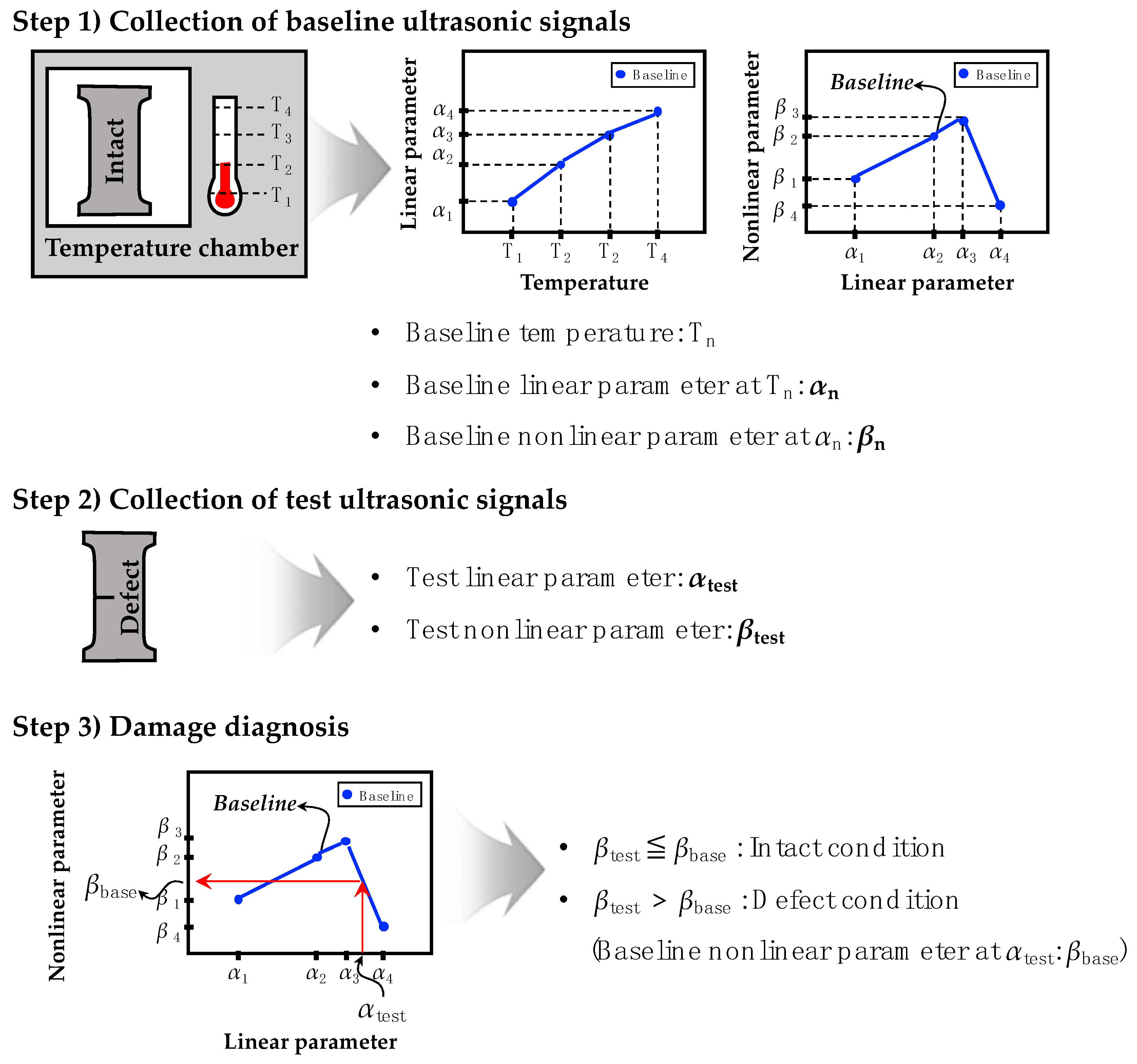
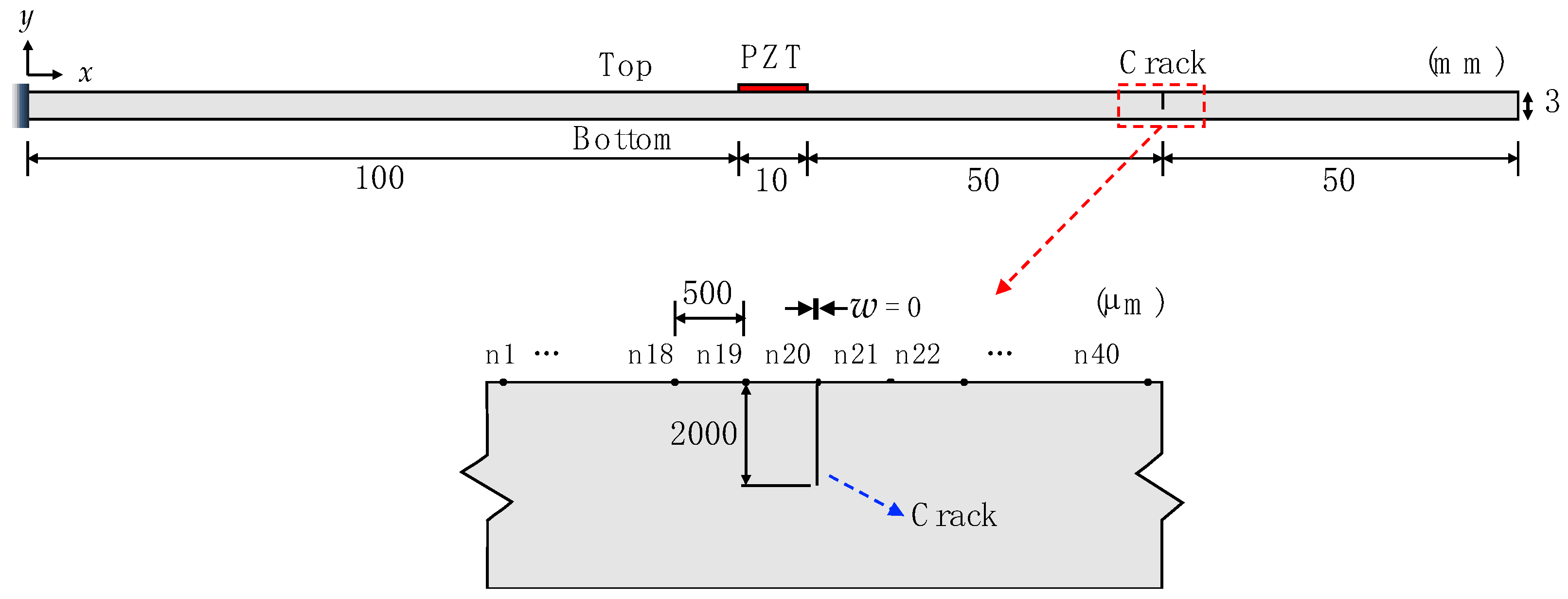
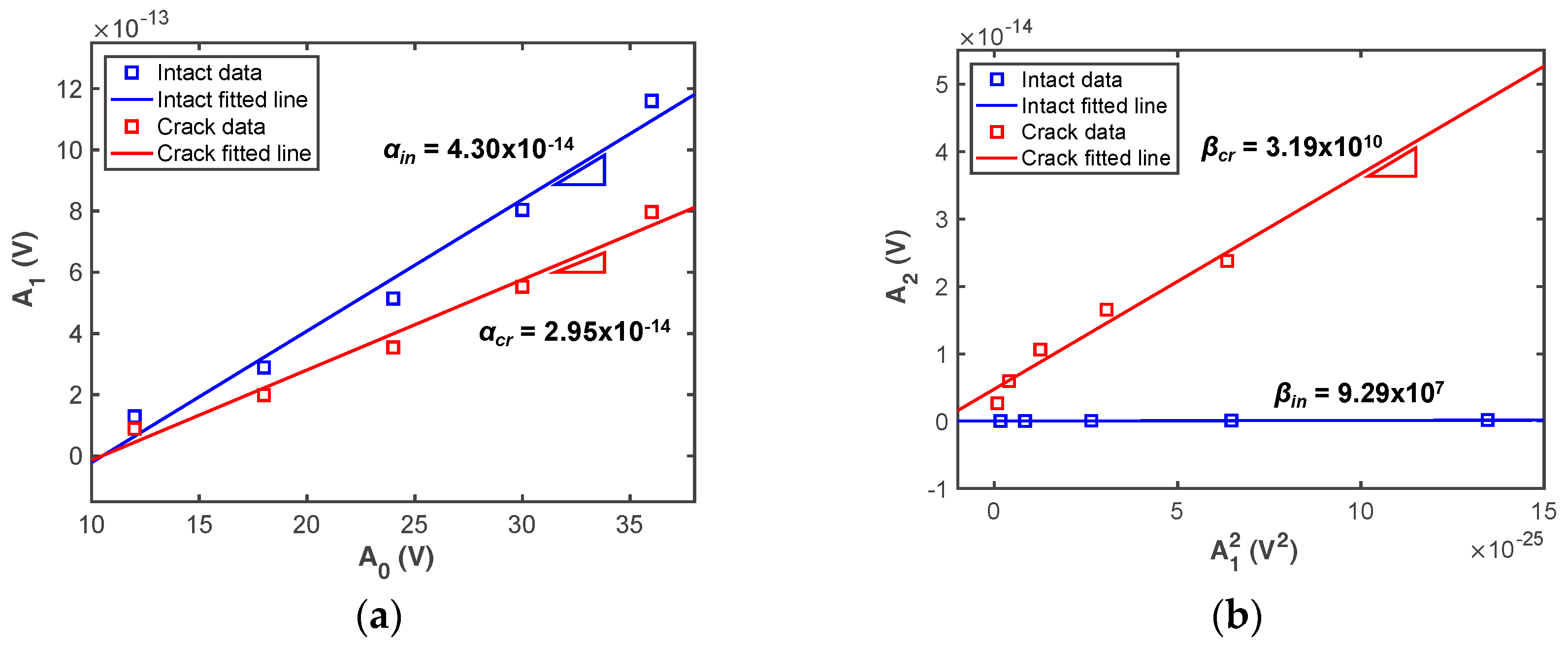
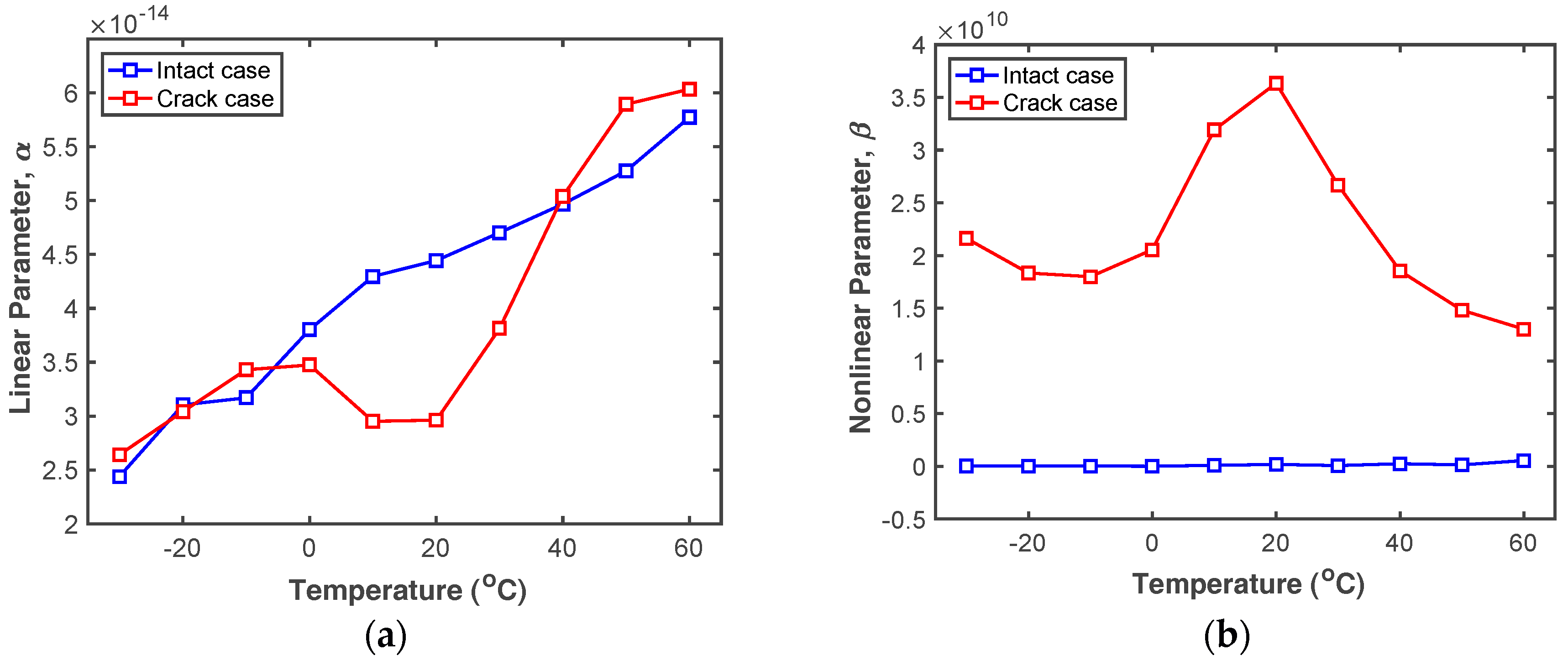

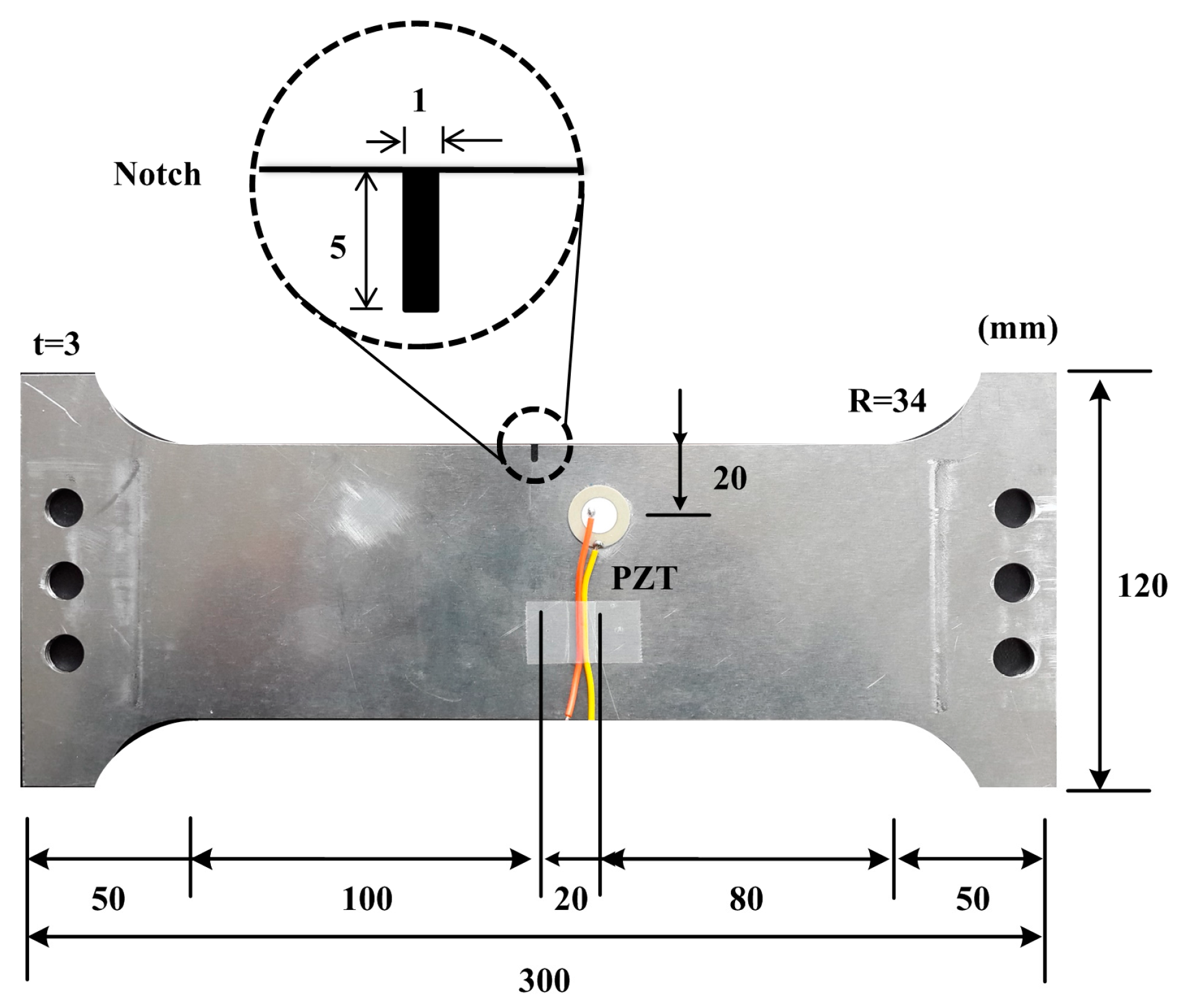


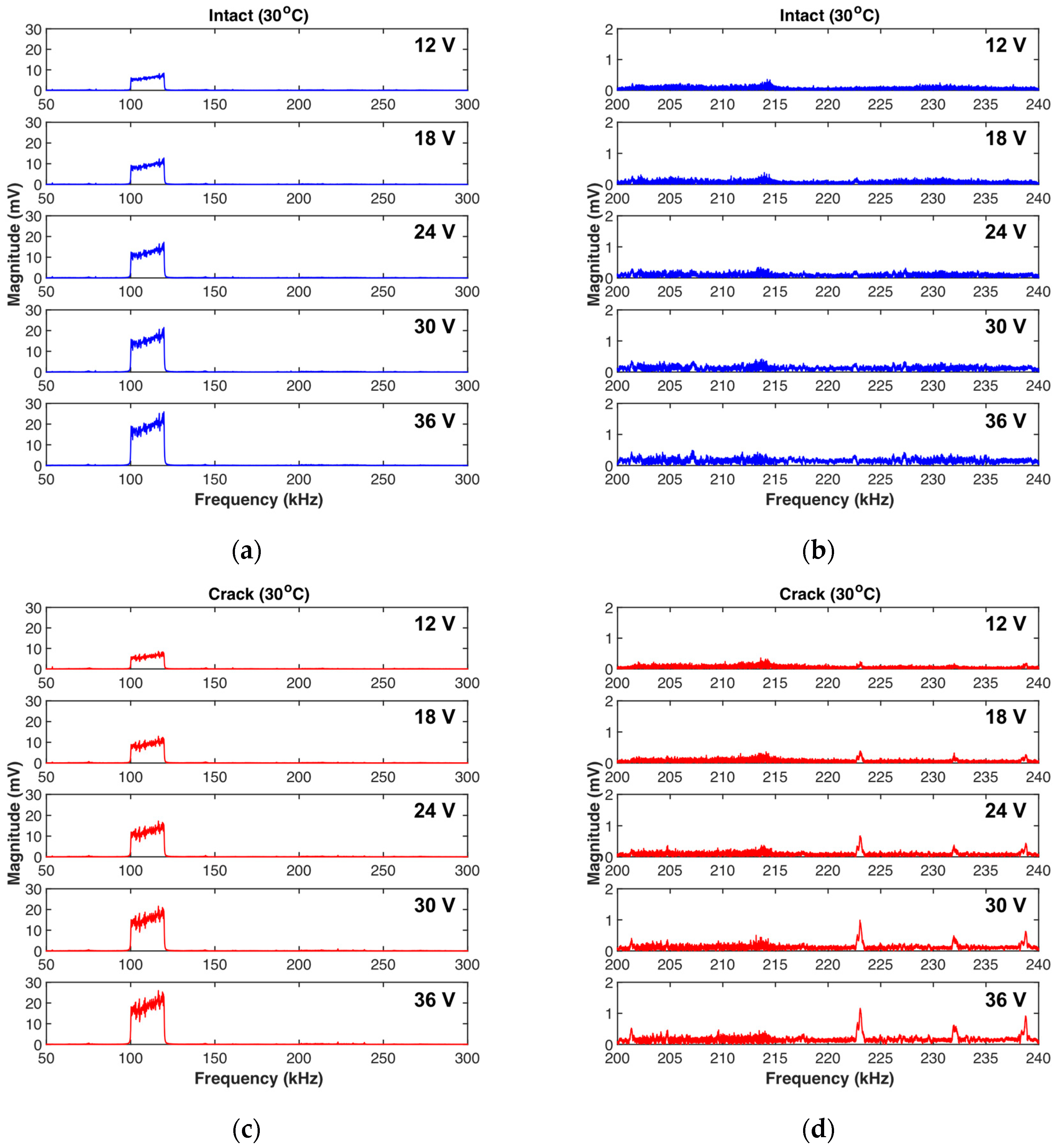

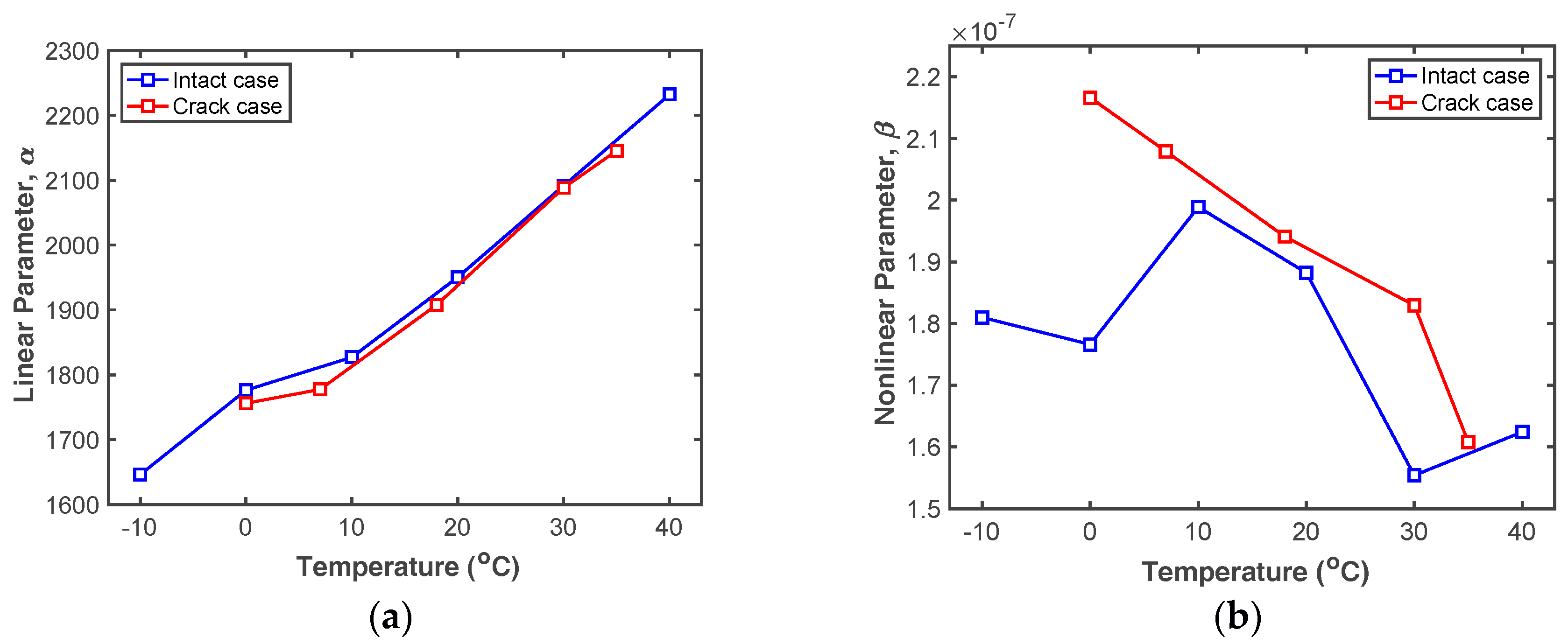
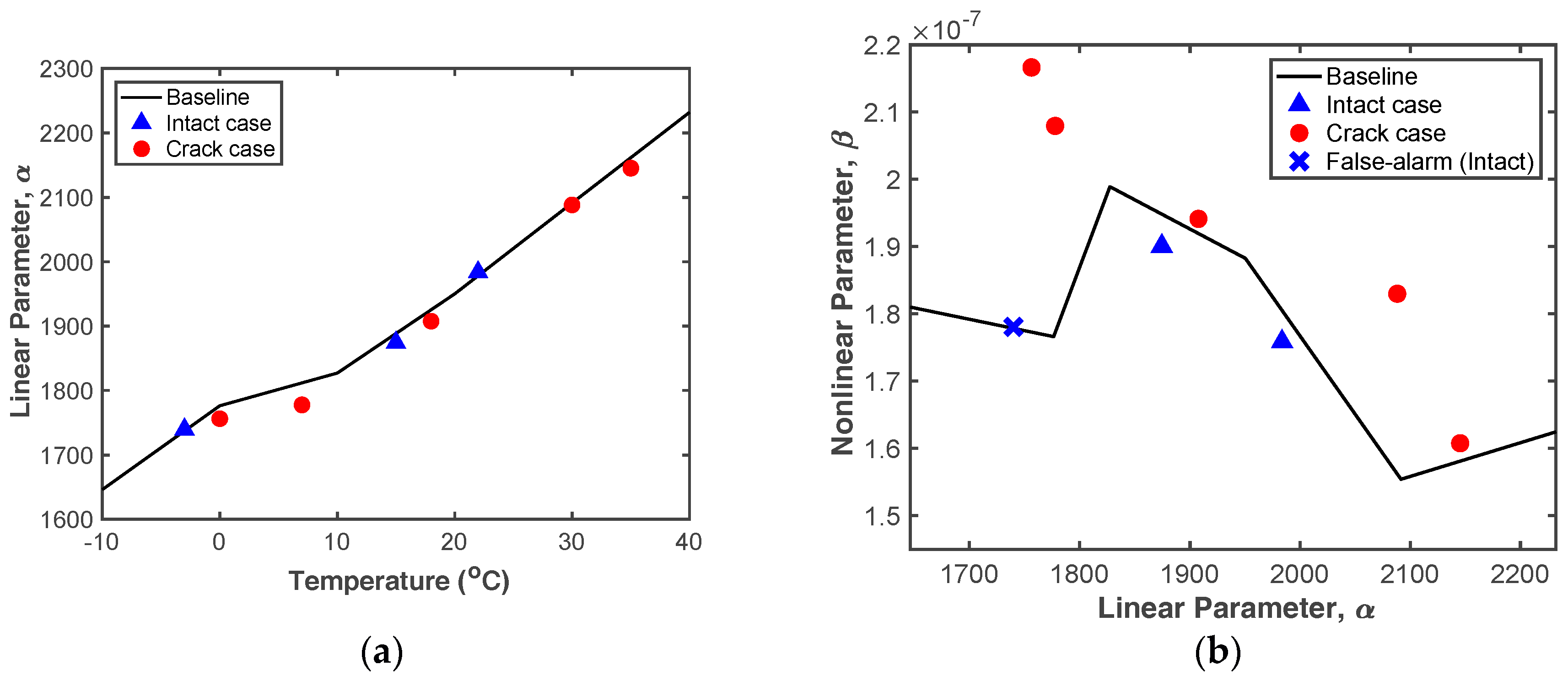
| Temperature (°C) | Density (kg/m3) | Young’s Modulus (GPa) |
|---|---|---|
| −100 | 2791.0 | 78.2 |
| −75 | 2785.5 | 77.3 |
| −50 | 2780.0 | 74.3 |
| −25 | 2774.5 | 73.3 |
| 0 | 2769.0 | 72.4 |
| 25 | 2763.5 | 68.0 |
| 50 | 2758.0 | 67.1 |
| 75 | 2752.5 | 66.1 |
| 100 | 2747.0 | 65.7 |
| Temperature (°C) | Dielectric Const. (x-axis) | Dielectric Const. (y-axis) | Piezoelectric Coef. (d15) (m/V) | Piezoelectric Coef. (-d31) (m/V) | Piezoelectric Coef. (d33) (m/V) |
|---|---|---|---|---|---|
| −100 | 8.4 × 10−9 | 7.3 × 10−9 | 6.9 × 10−10 | −1.6 × 10−10 | 4.4 × 10−10 |
| −75 | 9.7 × 10−9 | 8.4 × 10−9 | 7.0 × 10−10 | −1.8 × 10−10 | 4.7 × 10−10 |
| −50 | 11.1 × 10−9 | 9.6 × 10−9 | 7.1 × 10−10 | −2.1 × 10−10 | 5.0 × 10−10 |
| −25 | 12.4 × 10−9 | 10.7 × 10−9 | 7.2 × 10−10 | −2.3 × 10−10 | 5.3 × 10−10 |
| 0 | 13.7 × 10−9 | 11.9 × 10−9 | 7.3 × 10−10 | −2.5 × 10−10 | 5.6 × 10−10 |
| 25 | 15.1 × 10−9 | 13.0 × 10−9 | 7.4 × 10−10 | −2.7 × 10−10 | 5.9 × 10−10 |
| 50 | 16.4 × 10−9 | 14.2 × 10−9 | 7.5 × 10−10 | −3.0 × 10−10 | 6.3 × 10−10 |
| 75 | 17.7 × 10−9 | 15.3 × 10−9 | 7.6 × 10−10 | −3.2 × 10−10 | 6.6 × 10−10 |
| 100 | 19.0 × 10−9 | 16.5 × 10−9 | 7.7 × 10−10 | −3.4 × 10−10 | 6.9 × 10−10 |
| Data | Temperature (°C) | Condition |
|---|---|---|
| Baseline | −10, 0, 10, 20, 30, 40 | Intact |
| False-positive test | −3, 15, 22 | Intact |
| False-negative test | 0, 7, 18, 30, 35 | Cracked |
© 2018 by the authors. Licensee MDPI, Basel, Switzerland. This article is an open access article distributed under the terms and conditions of the Creative Commons Attribution (CC BY) license (http://creativecommons.org/licenses/by/4.0/).
Share and Cite
Kim, N.; Jang, K.; An, Y.-K. Self-Sensing Nonlinear Ultrasonic Fatigue Crack Detection under Temperature Variation †. Sensors 2018, 18, 2527. https://doi.org/10.3390/s18082527
Kim N, Jang K, An Y-K. Self-Sensing Nonlinear Ultrasonic Fatigue Crack Detection under Temperature Variation †. Sensors. 2018; 18(8):2527. https://doi.org/10.3390/s18082527
Chicago/Turabian StyleKim, Namgyu, Keunyoung Jang, and Yun-Kyu An. 2018. "Self-Sensing Nonlinear Ultrasonic Fatigue Crack Detection under Temperature Variation †" Sensors 18, no. 8: 2527. https://doi.org/10.3390/s18082527
APA StyleKim, N., Jang, K., & An, Y.-K. (2018). Self-Sensing Nonlinear Ultrasonic Fatigue Crack Detection under Temperature Variation †. Sensors, 18(8), 2527. https://doi.org/10.3390/s18082527






